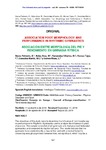Mostrar o rexistro simple do ítem
Association Foot Morphology and Performance in Rhythmic Gymnastics
| dc.contributor.author | Sierra Palmeiro, Elena | |
| dc.contributor.author | Bobo-Arce, Marta | |
| dc.contributor.author | Fernández-Villarino, María A. | |
| dc.contributor.author | Alonso-Tajes, Francisco | |
| dc.contributor.author | González-Martín, M. Carmen | |
| dc.contributor.author | Gómez-Rivas, Lucía | |
| dc.date.accessioned | 2020-11-23T18:37:26Z | |
| dc.date.available | 2020-11-23T18:37:26Z | |
| dc.date.issued | 2020 | |
| dc.identifier.citation | Sierra-Palmeiro, E., Bobo-Arce, M., Fernández-Villarino, M., Fernández-Villarino, M., Alonso-Tajes, F., González-Martin, M., & Gómez-Rivas, L. (2020). ASOCIACIÓN ENTRE MORFOLOGÍA DEL PIE Y RENDIMIENTO EN GIMNASIA RÍTMICA. Revista Internacional De Medicina Y Ciencias De La Actividad Física Y Del Deporte, 20(79), 567-583. https://doi.org/10.15366/rimcafd2020.79.012 | es_ES |
| dc.identifier.issn | 1577-0354 | |
| dc.identifier.uri | http://hdl.handle.net/2183/26745 | |
| dc.description.abstract | [Abstract] The objectives of the study were to determine the influence of foot morphology on performance in Rhythmic Gymnastics and to analyze the influence of years of practice. The sample consisted of 48 gymnasts who had practiced federated gymnastics and competed during the last year. The results indicate that the gymnasts have predominantly a neutral foot and with a normal footprint, presenting enough asymmetry between feet, not significant, which may be a consequence of asymmetric work and should be corrected in training. Only the range of amplitude of the talocrural joint seems to be a characteristic of foot morphology that affects technical performance and seems more an innate characteristic. The practice of rhythmic gymnastics might not be as decisive a factor as could be supposed in the morphological modifications of the footprint. | es_ES |
| dc.description.abstract | [Resumen] Los objetivos del estudio fueron determinar la influencia de la morfología del pie en el rendimiento en Gimnasia Rítmica y analizar la influencia de los años de práctica. La muestra estaba compuesta por 48 gimnastas que habían practicado gimnasia federada y competido durante el último año. Los resultados indican que las gimnastas tienen predominantemente un pie neutro y con huella normal, presentando bastante asimetría entre pies, no significativa, lo que puede ser consecuencia de un trabajo asimétrico y debería ser corregido en el entrenamiento. Sólo el rango de amplitud de la articulación talocrural parece ser una característica de la morfología del pie que incida sobre el rendimiento técnico y parece más una característica innata. La práctica de la Gimnasia Rítmica podría no ser un factor tan decisivo como podía suponerse en las modificaciones morfológicas de la huella plantar. | es_ES |
| dc.language.iso | eng | es_ES |
| dc.publisher | Universidad Autónoma de Madrid | es_ES |
| dc.relation.uri | https://doi.org/10.15366/rimcafd2020.79.012 | es_ES |
| dc.subject | Rhythmic gymnastics | es_ES |
| dc.subject | Performance | es_ES |
| dc.subject | Foot morphology | es_ES |
| dc.subject | Gimnasia rítmica | es_ES |
| dc.subject | Rendimiento | es_ES |
| dc.subject | Morfología del pie | es_ES |
| dc.subject | Ximnasia rítmica | es_ES |
| dc.subject | Rendemento | es_ES |
| dc.subject | Morfoloxía do pé | es_ES |
| dc.title | Association Foot Morphology and Performance in Rhythmic Gymnastics | es_ES |
| dc.title.alternative | Asociación entre morfología del pie y rendimiento en gimnasia rítmica | es_ES |
| dc.type | info:eu-repo/semantics/article | es_ES |
| dc.rights.access | info:eu-repo/semantics/openAccess | es_ES |
| UDC.journalTitle | Revista Internacional de Medicina y Ciencias de la Actividad Física y el Deporte | es_ES |
| UDC.volume | 20 | es_ES |
| UDC.issue | 79 | es_ES |
| UDC.startPage | 567 | es_ES |
| UDC.endPage | 583 | es_ES |
Ficheiros no ítem
Este ítem aparece na(s) seguinte(s) colección(s)
-
GI-ESAFEX - Artigos [25]
-
GI-INCIDE - Artigos [16]
-
GI-GIRS - Artigos [88]






